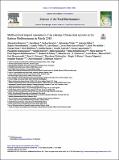Por favor, use este identificador para citar o enlazar a este item:
http://hdl.handle.net/10261/275520COMPARTIR / EXPORTAR:
 SHARE SHARE
 CORE
BASE CORE
BASE
|
|
| Visualizar otros formatos: MARC | Dublin Core | RDF | ORE | MODS | METS | DIDL | DATACITE | |

| Título: | Multi-sectoral impact assessment of an extreme African dust episode in the Eastern Mediterranean in March 2018 |
Autor: | Monteiro, Alexandra; Basart, Sara; Kazadzis, Stelios; Gkikas, Antonis; Vandenbussche, Sophie; Tobías, Aurelio CSIC ORCID; Gama, Carla; García-Pando, Carlos Pérez; Tarradellas, Enric; Notas, George; Middleton, Nick; Kushta, Jonilda; Amiridis, Vassilis; Lagouvardos, Kostas; Kosmopoulos, Panagiotis; Kotroni, Vasiliki; Kanakidou, Maria; Mihalopoulos, Nikolaos; Kalivitis, Nikos; Dagsson-Waldhauserová, Pavla; El-Askary, Hesham; Sievers, Klaus; Giannaros, T; Mona, Lucia; Hirtl, Marcus; Skomorowski, Paul; Nickovic, Slobodan; Votsis, Athanasios; Virtanen, Timo H; Christoudias, Theodoros; Di Mauro, Biagio; Trippetta, Serena; Kutuzov, Stanislav; Meinander, Outi | Palabras clave: | Solar radiation Aviation Dust episode Health Impacts Modelling Monitoring |
Fecha de publicación: | 22-jun-2022 | Editor: | Elsevier | Citación: | Science of the Total Environment 843: 156861 (2022) | Resumen: | In late March 2018, a large part of the Eastern Mediterranean experienced an extraordinary episode of African dust, one of the most intense in recent years, here referred to as the "Minoan Red" event. The episode mainly affected the Greek island of Crete, where the highest aerosol concentrations over the past 15 yeas were recorded, although impacts were also felt well beyond this core area. Our study fills a gap in dust research by assessing the multi-sectoral impacts of sand and dust storms and their socioeconomic implications. Specifically, we provide a multi-sectoral impact assessment of Crete during the occurrence of this exceptional African dust event. During the day of the occurrence of the maximum dust concentration in Crete, i.e. March 22nd, 2018, we identified impacts on meteorological conditions, agriculture, transport, energy, society (including closing of schools and cancellation of social events), and emergency response systems. As a result, the event led to a 3-fold increase in daily emergency responses compare to previous days associated with urban emergencies and wildfires, a 3.5-fold increase in hospital visits and admissions for Chronic Obstructive Pulmonary Disease (COPD) exacerbations and dyspnoea, a reduction of visibility causing aircraft traffic disruptions (eleven cancellations and seven delays), and a reduction of solar energy production. We estimate the cost of direct and indirect effects of the dust episode, considering the most affected socio-economic sectors (e.g. civil protection, aviation, health and solar energy production), to be between 3.4 and 3.8 million EUR for Crete. Since such desert dust transport episodes are natural, meteorology-driven and thus to a large extent unavoidable, we argue that the efficiency of actions to mitigate dust impacts depends on the accuracy of operational dust forecasting and the implementation of relevant early warning systems for social awareness. | Versión del editor: | https://doi.org/10.1016/j.scitotenv.2022.156861 | URI: | http://hdl.handle.net/10261/275520 | DOI: | 10.1016/j.scitotenv.2022.156861 | ISSN: | 00489697 |
| Aparece en las colecciones: | (IDAEA) Artículos |
Ficheros en este ítem:
| Fichero | Descripción | Tamaño | Formato | |
|---|---|---|---|---|
| 1-s2.0-S0048969722039584-main.pdf | Artículo principal | 5,43 MB | Adobe PDF |  Visualizar/Abrir |
CORE Recommender
PubMed Central
Citations
2
checked on 15-may-2024
SCOPUSTM
Citations
22
checked on 09-may-2024
WEB OF SCIENCETM
Citations
14
checked on 26-feb-2024
Page view(s)
48
checked on 13-may-2024
Download(s)
32
checked on 13-may-2024
Google ScholarTM
Check
Altmetric
Altmetric
Artículos relacionados:
NOTA: Los ítems de Digital.CSIC están protegidos por copyright, con todos los derechos reservados, a menos que se indique lo contrario.


